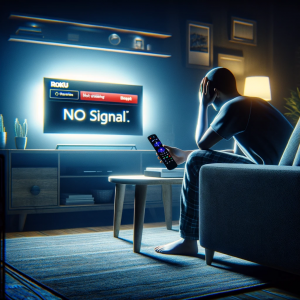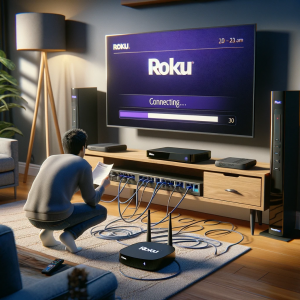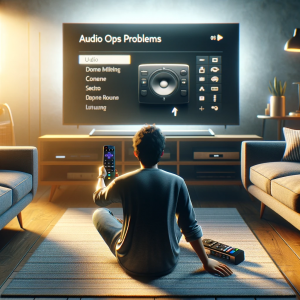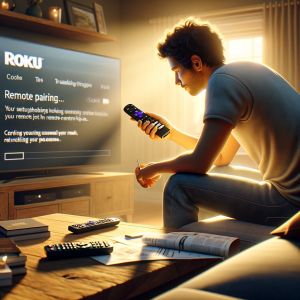Roku TV Not Working
Experiencing issues with your Roku device can be frustrating, especially when you’re looking forward to unwinding with your favourite shows and movies. A common problem many users encounter is their Roku not working or facing situations where Roku does not work as expected. This can stem from a number of problems ranging from internet connectivity problems to audio issues that disrupt your viewing experience. Our comprehensive guide is designed to navigate you through the myriad of problems you might be facing with your Roku. Whether your device is unresponsive, struggling with connectivity, or encountering audio glitches, we’ve got you covered. With step-by-step solutions for a broad spectrum of Roku issues, this guide aims to get your device back up and running smoothly, ensuring you can return to enjoying your favourite streaming content without any hitches. Stay tuned as we delve into specific troubleshooting techniques, from general device functionality to more intricate problems like internet and audio issues.
General Troubleshooting for Common Roku Problems:
Navigating through Roku issues can often feel like a daunting task, but with the right Roku troubleshooting steps, most problems can be resolved swiftly. This section is dedicated to addressing a wide array of common Roku problems that users might encounter. By adhering to these foundational troubleshooting strategies, you can tackle the challenges that may prevent your Roku device from operating optimally.
-
Restart Your Roku Device:
A simple yet effective first step in Roku troubleshooting involves restarting your device. This can resolve many temporary glitches, including freezing, lagging, or other erratic behaviour that contributes to Roku problems.
-
Check for Roku System Updates:
Outdated software is a common source of Roku issues. Regularly checking for & installing system updates is crucial. These updates can provide critical fixes to known Roku problems and improve overall performance.

-
Factory Reset Your Roku:
If the above steps don’t resolve your Roku problems, a more drastic but effective troubleshooting method is performing a factory reset. This will restore your Roku device to its original settings, potentially clearing up any deep-rooted issues. Be mindful that this will erase all personal settings and information, so it should be considered a last resort. To perform a factory reset, go to the settings menu, select “System,” then “Advanced system settings,” and finally “Factory reset.” Follow the on-screen instructions to complete the process.
-
Check Your Roku Internet Connection:
Many Roku issues stem from connectivity problems. Make sure your Roku device is connected to the internet & that the signal strength is strong. Sometimes, simply resetting your modem or router can improve your connection quality, thereby resolving Roku problems related to streaming and buffering.
By starting with these general Roku troubleshooting steps, you can address the most common Roku problems effectively. These foundational solutions are designed to tackle a wide range of difficulties, ensuring your Roku device returns to its optimal streaming performance.
Fixing Roku Connectivity Issues:
One of the most common frustrations for Roku users is when their device is not connecting to the internet leading to a plethora of Roku connectivity issues that can severely limit the device’s functionality. Whether your Roku “won’t connect at all or intermittently loses its connection, these steps are designed to tackle these issues head-on, ensuring a seamless streaming experience.
-
Check the Wi-Fi Signal Strength:
A weak Wi-Fi signal is a primary culprit behind many Roku issues, Begin by checking the signal strength in your Roku’s network settings. Navigate to Settings > Network > Check connection to test your Wi-Fi signal and internet speed. If the signal is poor, think about putting your Roku device closer to your network or removing any objects that could be blocking the signal.

-
Restart Your Modem and Router:
Sometimes, the problems lies not with the Roku itself but with your home network. Restarting your modem and router can refresh your connection and resolve many Roku not working problems.
-
Reset Network Connection on Your Roku:
If your Roku won’t connect after checking the signal and restarting your modem and router, try resetting the network connection on your Roku. Go to Settings > System > Advanced system settings > Network connection reset, and select “Reset connection.”
-
Update Your Router’s Firmware:
Outdated router firmware can lead to Roku not working problems to find out how to upgrade the firmware on your router, visit the manufacturer’s website or consult the user manual.
-
Change Your Wi-Fi Channel or Band:
Interference from other wireless networks can impact your Roku’s ability to maintain a stable connection. You can usually adjust the Wi-Fi band or channel on routers. Experiment with different channels or switch from a 2.4GHz band to a 5GHz band (or vice versa) to see if this improves your Roku’s connectivity.
By methodically addressing each of these areas, you can significantly reduce or eliminate the Roku not working issues that prevent your device from connecting to the internet.
Solving Roku Audio Problems:
Audio issues on Roku devices, particularly when there is no sound on Roku tv can detract from the streaming experience, leaving users in silence. This section aims to address Roku sound not working problems with targeted advice that ensures your favorite shows and movies sound as good as they look.
-
Verify the Mute Function and Volume Levels of Roku:
It may seem obvious, but the first step in troubleshooting no sound on Roku tv should be to check if the TV or connected sound system is accidentally muted or set to a low volume. Use your Roku remote to ensure the mute function hasn’t been activated and adjust the volume levels to see if this resolves the issue.
-
Inspect the Audio Settings on Your Roku:
If the mute function and volume levels are as they should be, the next step is to dive into the audio settings of your Roku device. Navigate to Settings > Audio to review your current setup.
-
Reboot Your Roku Device:
Temporary glitches causing no sound on Roku tv” can often be fixed by a simple restart. You can restart your Roku from the Settings menu or by unplugging the device from the power source for a few moments before plugging it back in. A restart can refresh the system and eliminate audio issues.
-
Troubleshoot External Speakers or Soundbars:
If you’re using an external audio system like speakers or a soundbar with your Roku TV, ensure they’re correctly connected and powered on. Verify that your Roku’s audio output settings are set to utilize the external system.
-
Try a Different Audio Cable or Port:
Faulty cables or ports can be responsible for audio problems. an If you’re using HDMI cable to connect your Roku device, try using a different cable or plugging it into a different HDMI port on your TV. Similarly, if you’re using an optical or analog audio cable for an external sound system, testing with a different cable or port may help.
-
Update Your Roku Device:
Outdated firmware can lead to various Roku not working issues, including audio problems. Navigate to Settings > System > System update > to see if there are any updates. Check right now. Installing the latest firmware for your Roku can fix bugs that may be causing Roku sound not working issues.
Through a logical use of these procedures, you can effectively address and resolve common audio issues, restoring clear sound to your Roku TV. Whether it’s a simple issue like the device being muted or more complex problems related to external audio systems.
What to Do If Your Roku TV or Device Won’t Turn On:
One of the more perplexing issues Roku users may face is when their Roku tv won’t turn on leaving them unable to access their favorite content. This section delves into solutions for power-related problems that prevent your Roku device from powering up, ensuring you’re not left in the dark.
-
Check the Power Supply:
The first step in troubleshooting a Roku TV won’t turn on issue is to check the power supply. Ensure that your Roku device is properly plugged into a working electrical outlet. Make sure your power strip or surge protector is turned on and operating properly if you’re using one..
-
Verify the Roku Remote’s Batteries:
A common reason why Roku tv won’t turn on is due to dead batteries in the remote control. Replace batteries in your Roku remote and attempt to turn on the device again.
-
Ensure the TV Isn’t in Standby Mode:
If your Roku device powers on but your TV screen remains blank, it’s possible that the TV is in standby or sleep mode. Use your TV’s remote (not the Roku remote) to turn it on or switch inputs to ensure the correct source is selected for your Roku device.
-
Check the HDMI Connection:
If you’re using a Roku streaming stick or box, ensure that it’s firmly connected to an HDMI port on your TV. Try using a different HDMI port or a different HDMI cable to rule out connectivity issues as the cause of the problem. For Roku TVs, ensure that all internal connections are secure and that the TV is not experiencing any hardware issues.
-
Perform a Power Cycle:
For both Roku TVs and streaming devices, performing a power cycle can help reset the system and resolve issues preventing it from turning on. Unplug the Roku device disconnect it from the power source, give it a minute, and then reconnect the plug. This can help clear any temporary errors that might be causing the device not to power up.
You may diagnose and perhaps fix any power-related issues stopping your Roku TV or device from turning on by carefully following these steps.
Resolving Roku Remote Control Issues:
A common setback for Roku users is encountering a situation where their Roku controller not working as it should. This guide will delve into effective strategies for tackling these remote control issues, ensuring you can navigate your Roku device seamlessly.
-
Replace the Batteries:
The first and simplest step to address a Roku controller not working issue is to check batteries. Usually, weak or empty batteries are at blame. Replace them with new ones to see if this resolves the problem.
-
Re-Pair the Remote:
If replacing the batteries doesn’t help, the next step is to re-pair your remote with your Roku device. To re-pair, disconnect your Roku device from power, then reconnect it. Once the home screen loads, press & hold the pairing button on your remote for about 3 seconds. The remote control should begin to flash its pairing light to show that it is in pairing mode.
-
Reset the Remote:
For more stubborn issues where the Roku controller not working persists, a remote reset might be necessary. Remove the batteries from the remote, then disconnect your Roku device from power. After waiting about a minute, reconnect your Roku and reinsert the batteries into the remote.
-
Check for Obstructions and Interference:
Ensure there are no obstructions between your remote and the Roku device that could block the signal. Also, consider potential sources of interference, such as other wireless devices, that could be affecting the remote’s performance. Moving your Roku device to a different location might help improve the remote’s responsiveness.
-
Use the Roku Mobile App:
If your remote is still not responding, the Roku mobile app, available for both iOS & Android devices, can serve as a temporary solution. The app features a remote control function that mimics the physical Roku remote, allowing you to control your Roku device from your phone.
-
Consider a Replacement Remote:
If all else fails and your Roku stick not responding to remote inputs remains unresolved, it might be time to consider purchasing a replacement remote. Roku offers remotes for purchase, or you may find a compatible third-party option that suits your needs.
By following these steps to address Roku controller not working issues, you can swiftly restore your ability to control your Roku device, ensuring uninterrupted access to your entertainment.
FAQs:
Q1: What should I do when my Roku device not working?
- A: Start by checking your internet connection, performing a system restart, and ensuring your device’s software is up to date. These initial steps can resolve many common issues related to Roku not working.
Q2: Why does my Roku say it’s connected to the internet but still doesn’t work?
- A: If your Roku is connected to internet but does not work try restarting your router and Roku device. Sometimes, the connection may be established but not strong enough for streaming, or the device may need a refresh to recognize the connection properly.
Q3: How can I fix audio problems on my Roku TV?
- A: For no sound on Roku tv issues, verify that the volume is not muted or too low, check the audio settings on your Roku device, and ensure the audio cables (if any) are securely connected. Rebooting your Roku can also help resolve audio glitches.
Q4: What do I do if my Roku remote is not working?
- A: If your Roku controller not working, replace the batteries first. If the issue persists, try re-pairing the remote with your Roku device or use the Roku mobile app as a temporary remote. For persistent problems, a replacement remote may be necessary.
Q5: Why won’t my Roku connect to WiFi?
- A: If your Roku won’t connect to WiFi, ensure you’re entering the correct network password. Check for signal interference or try moving your Roku closer to your router. Restarting both your Roku device and router can also solve connectivity issues.
Conclusion:
Navigating through the challenges of Roku not working can be a frustrating experience for any user. This comprehensive guide has aimed to arm you with the necessary tools and knowledge to tackle a wide array of common Roku issues, from connectivity and audio problems to remote control malfunctions and specific app glitches.
Regular updates are crucial for the smooth operation of your Roku device. Keeping your Roku system and its applications up to date ensures you have the latest features & bug fixes, minimizing the likelihood of encountering Roku not working issues. Always make it a practice to check for and apply updates regularly to maintain optimal performance of your Roku device.
To know more about Roku TV and resolve its related issues, visit Roku support page.

William wilson
What Should I Do When My Roku TV Has No Sound, Despite Being Properly Connected and Not Muted?
Support Admin
If you’re experiencing no sound on your Roku TV, the first step is to ensure the TV isn’t muted and the volume is set appropriately. Next, navigate to the audio settings by going to Settings > Audio on your Roku device to verify that the settings align with your audio setup, such as ensuring the audio mode is correctly configured for your TV or external speakers. If you’re using an HDMI or optical cable for an external audio system, ensure the connections are secure. Restarting your Roku device can also help clear any temporary glitches causing audio issues. If these steps don’t resolve the problem, checking for system updates under Settings > System > System update can ensure your device has the latest software, potentially fixing any known audio bugs.
Nancy Jones
How Can I Fix My Roku Controller When It’s Not Responding or Working Properly?
Support Admin
For a Roku controller not working, start by replacing the batteries, as this is a common issue with unresponsiveness. If this doesn’t work, try re-pairing the remote with your Roku device. This can be done by unplugging your Roku device, plugging it back in, and once it’s booted up, pressing and holding the pairing button on the remote for about 3 seconds. If the remote still isn’t working, a reset might be necessary. Remove the batteries, disconnect the Roku device for a minute, then reconnect and reinsert the batteries. Also, ensure there’s no obstruction between the remote and the device and consider using the Roku mobile app as an alternative control method. If issues persist, it may be time to consider purchasing a new Roku remote.
Karen wilson
I’m Facing Troubles With My Roku Device, Such as Streaming Issues and Connectivity Problems. What General Troubleshooting Steps Should I Follow?
Support Admin
For general Roku troubleshooting, begin by restarting your Roku device to address any temporary streaming or connectivity issues. This simple step can resolve many common Roku troubles. Next, ensure your device’s software is up to date by navigating to Settings > System > System update > Check now, as this can solve many known issues. If you’re facing connectivity problems, check your internet connection’s strength via Settings > Network > Check connection and consider restarting your modem and router to improve the connection quality. If problems persist, a factory reset might be necessary, but remember, this will erase all personal settings and information on your device.